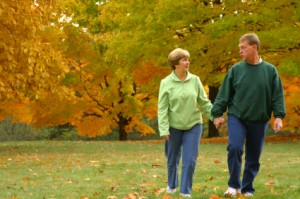 One of the most promising bits of research in the often grim field of senile dementia studies proposes a simple activity that may slow the progress of both Alzheimer’s disease and the “mild cognitive impairment” that develops into Alzheimer’s among about half of its sufferers. Significant reduction of cognitive decline and a possibly protective effect are tied to walking about five miles a week (a daily average of some three-quarters of a mile, or eight or nine city blocks). Among younger and symptom-free adults, a protective effect may kick in at about six miles per week.
One of the most promising bits of research in the often grim field of senile dementia studies proposes a simple activity that may slow the progress of both Alzheimer’s disease and the “mild cognitive impairment” that develops into Alzheimer’s among about half of its sufferers. Significant reduction of cognitive decline and a possibly protective effect are tied to walking about five miles a week (a daily average of some three-quarters of a mile, or eight or nine city blocks). Among younger and symptom-free adults, a protective effect may kick in at about six miles per week.
Up to five million of us in the U.S. suffer from Alzheimer’s disease, a number that can be expected to increase with the aging of the baby boom generation. Of course, research continues on causes and a cure for this so far intractable malady. Meanwhile, other scientists focus on ameliorating the effects of the degenerative disorder that robs us of our ability to reason, our memories, our connections to those we love, and ultimately our personalities, as we slip into Shakespeare’s “second childishness and mere oblivion.”
New Research Correlates More Walking with Both Higher Brain Volume and Better Function
The latest data is from an ongoing, twenty-year study on the walking patterns of 426 adults, by now averaging in age from 78 to 81. About a fifth of the subjects have been diagnosed with mild cognitive impairment and about a tenth with Alzheimer’s. MRI scans assessed brain volume in the research subjects, and a standard test of cognitive function measured cognitive decline over five years.
Higher levels of physical activity correlated not only with preservation of brain volume —signifying less brain cell death—but with preservation of brain structure in the areas associated with memory and learning. (“Confounding factors” such as sex, age, head size, education and body fat were controlled for.) Memory decline was slower in the more-active group.
The five-mile threshold showed up most dramatically in the mini mental state exam (MMSE). Among subjects who started out with some degree of cognitive impairment, those who walked five miles or more weekly showed a decline of a single point in their score over five years, while those who walked less declined an average of five points (out of thirty).
We need to note that this study was observational, and not leap blindly from observing a correlation to ascribing cause and effect. An alternative explanation of the correlation is that among those already more irreversibly on a path toward cognitive decline, one of the many ways in which they might be affected is becoming less active. Since the study is longitudinal (conducted over many years), this should be an easy variable to factor out, but early reports have not addressed this issue. More information will follow as the study undergoes peer review prior to publication. (Current reports are based on a presentation given by lead author Cyrus Raji at a meeting of the Radiological Society of North America.)
Why and How Walking Can Be Proactive
That said, both physical and mental activity in mid-life are known to protect against a myriad of diseases in general. Physical activity assures adequate blood flow to the brain, helps keep neurotransmitters in balance, and is good for the heart. (People with cardiac conditions, of course, need to carefully weigh risk versus benefit in choosing their amount and kind of exercise.)
Maintaining physical activity also specifically helps prevent obesity, forestalls insulin resistance and diabetes, and lowers blood pressure. Obesity, high blood pressure and diabetes are all risk factors for Alzheimer’s. One theoretical model, based on observation of insulin activity within the brain, goes so far as to claim Alzheimer’s as “type 3 diabetes”. Be that as it may, a sedentary lifestyle and high-fat diet correlates with greater Alzheimer’s risk. (At least one study shows cognitive decline after even a single high-fat meal.)
Walking has other health benefits, some of them specifically relevant to Alzheimer’s.
Walking, like other physical activity, helps improve the cholesterol profile, which is also implicated in both onset and progress of Alzheimer’s.
Walking outdoors increases sun exposure, which increases vitamin D within the body. There is growing consensus that current official recommendations for vitamin D levels are too low, and vitamin D3 has been shown to help the immune system clear the brain of amyloid beta, a key component of the amyloid plaques that are a physiological marker of Alzheimer’s.
Walking over unpaved terrain—gravel, sand, dirt or grass—stimulates the sensory nerves in the bottom of the feet, and helps forestall or ameliorate peripheral neuropathy. Some research suggests that the first signs of Alzheimer’s may not be cognitive decline, but difficulties with balance and walking. Regular training of the feet through park or country walks can help forestall problems in these areas.
Walking, like reading, involves rhythmic, lateral eye movements (left to right, right to left) as one scans one’s surroundings. This too correlates with protection against cognitive decline (and incidentally is perhaps the most significant physiological difference between reading print on a page versus reading it on a computer screen, which has been shown to involve considerably less lateral eye movement.)
In short, there’s really no downside to promoting walking as a possible way to protect against cognitive decline. Some of the potential benefits are particularly enhanced by walking in the off-grid context: outdoors, off-pavement. And the benefits can be shared by the whole family: at-risk or even suffering seniors may forestall further decline; middle-agers can enjoy preventive benefits; and the young can be encouraged to develop a life-long habit of healthy activity that will serve them well … on grid or off.
If you liked this article you may be interested in this product from our sponsor.

 Off The Grid News Better Ideas For Off The Grid Living
Off The Grid News Better Ideas For Off The Grid Living



